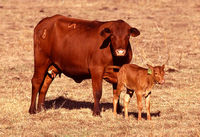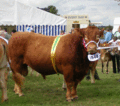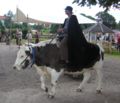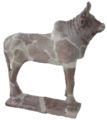Cattle
2007 Schools Wikipedia Selection. Related subjects: Food and agriculture
| iCattle | ||||||||||||||||
|---|---|---|---|---|---|---|---|---|---|---|---|---|---|---|---|---|
 Friesian/Holstein cow
|
||||||||||||||||
|
|
||||||||||||||||
|
Domesticated
|
||||||||||||||||
| Scientific classification | ||||||||||||||||
|
||||||||||||||||
|
|
||||||||||||||||
| Bos taurus Linnaeus, 1758 |
Cattle (often called cows in vernacular and contemporary usage, or kye as the Scots plural of cou) are domesticated ungulates, a member of the subfamily Bovinae of the family Bovidae. They are raised as livestock for meat (called beef and veal), dairy products (milk), leather and as draught animals (pulling carts, plows and the like). In some countries, such as India, they are subject to religious ceremonies and respect. It is estimated that there are 1.4 billion head of cattle in the world today.
Cattle were originally identified by Carolus Linnaeus as three separate species. These were Bos taurus, the European cattle, including similar types from Africa and Asia; Bos indicus, the zebu; and the extinct Bos primigenius, the aurochs. The aurochs is ancestral to both zebu and European cattle. More recently these three have increasingly been grouped as one species, sometimes using the names Bos primigenius taurus, Bos primigenius indicus and Bos primigenius primigenius. Complicating the matter is the ability of cattle to interbreed with other closely related species. Hybrid individuals and even breeds exist, not only between European cattle and zebu but also with yaks, banteng, gaur, and bison, a cross-genera hybrid. For example, genetic testing of the Dwarf Lulu breed, the only humpless "Bos taurus-type" cattle in Nepal, found them to be a mix of European cattle, zebu and yak. Cattle cannot successfully be bred with water buffalo or African buffalo. (See aurochs for the history of domestication, and zebu for peculiarities of that group.)
Terminology
The word "cattle" did not originate as a name for bovine animals. It derives from the latin caput, head, and thus originally meant "unit of livestock" or "one head". The word is closely related to "chattel" (a unit of property) and to "capital" in the sense of "property."
Older English sources like King James Version of the Bible refer to livestock in general as cattle. Additionally other species of the genus Bos are often called cattle or wild cattle. This article refers to the common modern meaning of "cattle", the European domestic bovine.
The term cattle itself is not a plural, but a mass noun. Thus one may refer to some cattle, but not three cattle. There is no universally used singular equivalent in modern English to cattle other than the various gender and age-specific terms (though "catron" is occasionally seen as a half-serious proposal). Strictly speaking, the singular noun for the domestic bovine is ox: a bull is a male ox and a cow is a female ox. That this was once the standard name for domestic bovines is shown in placenames such as Oxford. But "ox" is now rarely used in this general sense. Today "cow" is frequently used by the general population as a gender-neutral term, although it is meant to be used solely to mean female (females of other animals, such as whales or elephants, are also called cows). To refer to a specific number of these animals without specifying their gender, it must be stated as (for example) "ten head of cattle." Some Australian, Canadian, New Zealand and Scottish farmers use the term "cattlebeast" or simply "beast".
Obsolete terms for cattle include "neat" (horned oxen, from which " neatsfoot oil" is derived), "beef" (young ox) and "beefing" (young animal fit for slaughtering). Cattle raised for human consumption are called beef cattle. Within the beef cattle industry in parts of the United States, the older term beef (plural beeves) is still used to refer to an animal of either gender. Cows of certain breeds that are kept for the milk they give are called dairy cows.
Young cattle are called calves. A young female before she has calved the second time is called a heifer (pronounced "heffer"). A young female that has had only one calf is sometimes called a "first-calf heifer." In the USA male cattle bred for meat are castrated unless needed for breeding. The castrated male is then called a bullock or steer, unless kept for draft purposes, in which case it is called an ox (plural oxen), not to be confused with the related wild musk ox. If castrated as an adult, it is called a stag. An intact male is called a bull. An adult female over two years of age (approximately) is called a cow. The archaic plural of cow is kine or kyne (which comes from the same English stem as cow). The adjective applying to cattle is bovine.
Biology
Cattle are ruminants, meaning that they have a digestive system that allows them to utilize otherwise undigestible foods by repeatedly regurgitating and rechewing them as "cud." The cud is then reswallowed and further digested by specialized microorganisms that live in the rumen. These microbes are primarily responsible for generating the volatile fatty acids (VFAs) that cattle use as their primary metabolic fuel. The microbes that live inside of the rumen are also able to synthesize amino acids from non-protein nitrogenous sources such as urea and ammonia. These features allow cattle to thrive on grasses and other vegetation.
Cattle have four stomachs, with four compartments in each stomach. They are the rumen, reticulum, omasum, and abomasum. The rumen is the largest compartment and the reticulum is the smallest compartment. Cattle sometimes consume pie plates which are deposited in the reticulum, and this is where hardware disease occurs. The reticulum is known as the "Honeycomb." The omasum's main function is to absorb water and nutrients from the digestible feed. The omasum is known as the "Many Plies." The abomasum is most like the human stomach; this is why it is known as the "True Stomach."
The aurochs was originally spread throughout Europe, Africa, and Asia. In historical times, their range was restricted to Europe, and the last animals were killed by poachers in Masovia, Poland, in 1627. Breeders have attempted to recreate the original gene pool of the aurochs by careful crossing of commercial breeds, creating the Heck cattle breed.
A popular conception about cattle (primarily bulls) is that they are enraged by the colour red. This is incorrect, as cattle are colour-blind. The myth arose from the use of red capes in the sport of bullfighting; in fact, two different capes are used. The capote is a large, flowing cape that is magenta and yellow. The more famous muleta is the smaller, red cape, used exclusively for the final, fatal segment of the fight. It is not the colour of the cape that angers the bull, but rather the movement of the fabric that irritates the bull and incites it to charge.
The gestation period for a cow is nine months. A newborn calf weighs approximately 80-100 pounds. Cows' natural lifespan could be 55 years, however most modern dairy cows are slaughtered at about 5 to 7 years.
A single cow emits enough nitrogen gas in a single day to fill 144 litre bottles.
Uses of cattle
Cattle occupy a unique role in human history, domesticated since at least the early Neolithic. They are raised for meat ( beef cattle), milk ( dairy cattle), and hides. They are also used as draft animals and in certain sports. Some consider cattle the oldest form of wealth, and cattle raiding consequently the earliest form of theft.
In Portugal, Spain and some Latin American countries, bulls are used in the sport of bullfighting while a similar sport Jallikattu is seen in South India; in many other countries this is illegal. Other sports such as bull riding are seen as part of a rodeo, especially in North America. Bull-leaping, a central ritual in Bronze Age Minoan culture (see Bull (mythology)), still exists in south-western France.
The outbreaks of bovine spongiform encephalopathy ( mad cow disease) have limited some traditional uses of cattle for food, for example the eating of brains or spinal cords.
Cattle husbandry
Cattle are often raised by allowing herds to graze on the grasses of large tracts of rangeland called ranches. Raising cattle in this manner allows the productive use of land that might be unsuitable for growing crops. The most common interactions with cattle involve daily feeding, cleaning and milking. Many routine husbandry practices involve ear tagging, dehorning, loading, medical operations, vaccinations and hoof care; some of these enhancing the cattle's welfare in the long term but tending to create negative qualities to human-animal interactions. A stockperson’s attitude, behaviour, gender, previous experiences, and culture are known to be important in cattle handling. The importance of cultural factors is emphasised when comparing cattle management in Europe compared to nomadic Fulani cattle management in Africa. The cattle husbandry of Fulani men rests on behavioural techniques, whereas in Europe cattle are controlled primarily by physical means like fences.
Breeders can utilise cattle husbandry to reduce M. bovis infection susceptibility by selective breeding and maintaining herd health to avoid concurrent disease. Cattle are farmed for beef, veal, dairy, leather and they are sometimes used simply to maintain grassland for wildlife e.g Epping Forest, England. They are often used in some of the most wild places for livestock. Depending on the breed, cattle can survive on hill grazing, heaths, marshes, moors and semi desert. Modern cows are more commercial than older breeds and having become more specialised are less versatile. For this reason many smaller farmers still favour old breeds, e.g Jersey. When more people started to settle in America farmers tended to have huge herds of cattle over massive pieces of land - this is ranching.
Ox
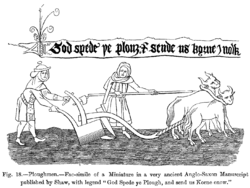

Oxen (plural of ox) are large and heavy set breeds of Bos Taurus cattle trained as draft animals. Often they are adult, castrated males. Usually an ox is over four years old due to the need for training and to allow it to grow to full size. Oxen are used for plowing, transport, hauling cargo, grain-grinding by trampling or by powering machines, irrigation by powering pumps, and wagon drawing. Oxen were commonly used to skid logs in forests, and sometimes still are, in low-impact select-cut logging. Oxen are most often used in teams of two, paired, for light work such as carting. In the past, teams might have been larger, with some teams exceeding twenty animals when used for logging.
An ox is nothing more than a mature bovine with an "education." The education consists of the animal's learning to respond appropriately to the teamster's (ox driver's) signals. These signals are given by verbal commands or by noise (whip cracks) and many teamsters were known for their voices and language. In North America, the commands are (1) get up, (2) whoa, (3) back up, (4) gee (turn to the right) and (5) haw (turn to the left). Oxen must be painstakingly trained from a young age. Their teamster must make or buy as many as a dozen yokes of different sizes as the animals grow. A wooden yoke is fastened about the neck of each pair so that the force of draft is distributed across their shoulders. From calves, oxen are chosen with horns since the horns hold the yoke in place when the oxen lower their heads, back up, or slow down (particularly with a wheeled vehicle going downhill). Yoked oxen cannot slow a load like harnessed horses can; the load has to be controlled downhill by other means. The gait of the ox is often important to ox trainers, since the speed the animal walks should roughly match the gait of the ox driver who must work with it.
American ox trainers favored larger breeds for their ability to do more work and for their intelligence. Because they are larger animals, the typical ox is the male of a breed, rather than the smaller female. Females are potentially more useful producing calves and milk.
Oxen can pull harder and longer than horses, particularly on obstinate or almost un-movable loads. This is one of the reasons that teams were dragging logs from forests long after horses had taken over most other draught uses in Europe and the New World. Though not as fast as horses, they are less prone to injury because they are more sure-footed and do not try to jerk the load.
An "ox" is not a unique breed of bovine, nor have any "blue" oxen lived outside the folk tales surrounding Paul Bunyan, the mythical American logger.
Many oxen are still in use worldwide, especially in developing countries. In the Third World oxen can lead lives of misery, as they are frequently malnourished. Oxen are driven with sticks and goads when they are weak from malnutrition. When there is insufficient food for humans, animal welfare has low priority.
Cattle in religion, traditions and folklore
- The Evangelist St. Luke is depicted as an Ox in Christian art.
- In Judaism, as described in Numbers 19:2, the ashes of a sacrificed unblemished red heifer that has never been yoked can be used for ritual purification of people who came into contact with a corpse.
- Cows are venerated within the Hindu religion of India. According to Vedic scripture they are to be treated with the same respect 'as one's mother' because of the milk they provide; "The cow is my mother. The bull is my sire.".. They appear in numerous stories from the Puranas and Vedas, for example the deity Sri Krishna is brought up in a family of cowherders and Lord Shiva is said to ride on the back of a bull. Bulls in particular are seen as a symbolic emblem of selfless duty and religion. In ancient India every household had a few cows which provided a constant supply of milk and a few bulls that helped as draft animals. Thus the Hindus felt it was economically wise to keep them rather than consume their flesh for a single meal. See Sacred cow for more on this topic.
- The ox is one of the 12-year cycle of animals which appear in the Chinese zodiac related to the Chinese calendar. See: Ox (Zodiac).
- The constellation Taurus represents a bull.
- For the mythology and lore connected with the bull, see Bull (mythology).
- An apocryphal story has it that a cow started the Great Chicago Fire by kicking over a kerosene lamp. Michael Ahern, the reporter who created the cow story, admitted in 1893 that he had made it up because he thought it would make colorful copy.
- On February 18, 1930 Elm Farm Ollie became the first cow to fly in an airplane and also the first cow to be milked in an airplane.
- A humorous anecdote among farmers suggests that instant death will come to anyone bitten by a cattle's upper front teeth. The joke is apparent to anyone who knows that a cow possesses no such teeth.
- The first known law requiring branding in North America was enacted on February 5, 1644 by Connecticut. It said that all cattle and pigs have to have a registered brand or earmark by May 1, 1644.
Cattle in popular culture
Cattle are thought by many to be inherently funny, and appear often in popular culture. Most of the time, the cattle in question is a Holstein cow, since this breed's black on white markings best represent a stereotypical 'cow'. This is largely because of the essentially stationary and unreactive nature of the domestic cow, which makes them appear wry, as well as their propensity for flatulence. The discordant sound made by a cow in distress is also held to be very funny.
Gallery
|
Pottery Bull from Chogha Zanbil, Iran. |
|||

